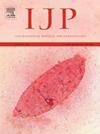圆线虫幼虫及其排泄物/分泌物的 microRNA 组,以及马动脉组织中寄生虫衍生 microRNA 的鉴定。
IF 3.2
2区 医学
Q1 PARASITOLOGY
引用次数: 0
摘要
马血虫(Strongylus vulgaris)是一种高致病性寄生虫,可造成致命的血管和肠道损伤。寄生虫会表达和释放 microRNA(miRNA),用于内部调节和调节宿主免疫。本研究的目的是注释粗毛蝇 L4 和 L5 阶段的 miRNA 组,并研究不同幼虫阶段和性别之间 miRNA 丰度的差异。此外,我们还想确定在幼虫的排泄物/分泌物(ESPs)以及幼虫的偏爱部位--颅肠系膜动脉(CMA)的动脉组织中是否能检测到 miRNAs。从自然感染的马驹身上采集幼虫,并按性别和阶段进行分类。一部分幼虫被快速冷冻,剩下的幼虫则进行孵化并收集(ESPs)。从 CMA 采集动脉血管组织样本。使用小 RNA 测序和定制的生物信息学管道进行注释。我们在幼虫体内鉴定出 142 个 S. vulgaris miRNA,在 ESPs 中鉴定出 136 个。幼虫与 ESPs 之间、L5 雌虫(L5Fs)与 L5 雄虫(L5Ms)之间、L4s 与 L5Fs 之间以及 L4s 与 L5Ms 之间的 miRNA 丰度存在显著差异。 L4s 与 L5s 之间总体上没有差异。在 ESPs 中,有几种 miRNA 在所有组别中含量不同。通过定量实时荧光定量 PCR(qPCR)进行验证,检测了幼虫和 ESPs 中选定的 miRNA 及其丰度差异。在一些马动脉组织样本中检测到一种寄生虫衍生的 miRNA,但含量很低。这项研究首次注释了草履虫的 miRNA 组。大多数已注释的幼虫 miRNA 也能在 ESPs 中检测到,幼虫的 miRNA 丰度在不同性别之间存在差异,ESPs 的 miRNA 丰度在不同性别和阶段之间也存在差异。不过,寄生虫衍生的 miRNA 在宿主动脉周围组织中的检测结果并不一致。本文章由计算机程序翻译,如有差异,请以英文原文为准。

The microRNAome of Strongylus vulgaris larvae and their excretory/secretory products with identification of parasite-derived microRNAs in horse arterial tissue
The equine bloodworm, Strongylus vulgaris, is a highly pathogenic parasite causing potentially fatal vascular and intestinal damage. Parasites express and release microRNAs (miRNAs) for internal regulation and to modulate host immunity. The complete set of miRNAs expressed by S. vulgaris (the S. vulgaris miRNAome) remains unannotated and the aim of this study was to annotate the miRNAome of L4 and L5 stages of S. vulgaris, and to examine differences in miRNA abundance between larval stages and sexes. Furthermore, we aimed to determine if miRNAs were detectable in excretory/secretory products (ESPs) from larvae and in arterial tissue from their predilection site, the cranial mesenteric artery (CMA). Larvae were collected from naturally infected foals, and categorized by sex and stage. A subset of larvae was snap-frozen, while those remaining were incubated and the (ESPs) collected. Arterial tissue samples were collected from the CMA. Small RNA sequencing, followed by a custom bioinformatic pipeline, was used for annotation. We identified 142 S. vulgaris miRNAs in larvae and 136 in ESPs. Significant differences in miRNA abundance were observed between larvae and ESPs, and between L5 females (L5Fs) and L5 males (L5Ms), L4s and L5Fs, and L4s and L5Ms. No differences were found between L4s and L5s overall. In ESPs, several miRNAs were differentially abundant across all groups. Validation through quantitative real-time PCR (qPCR) detected selected miRNAs and their differential abundance in larvae and ESPs. One parasite-derived miRNA was detected in some of the horse arterial tissue samples but at very low levels. This study provided the first annotation of the S. vulgaris miRNAome. Most of the annotated larval miRNAs were also detectable in ESPs, and differences in miRNA abundance between sexes were found for larvae, and between sexes and stages for ESPs. Parasite-derived miRNAs were, however, not consistently detectable in the surrounding host arterial tissue.
求助全文
通过发布文献求助,成功后即可免费获取论文全文。
去求助
来源期刊
CiteScore
8.40
自引率
2.50%
发文量
76
审稿时长
23 days
期刊介绍:
International Journal for Parasitology offers authors the option to sponsor nonsubscriber access to their articles on Elsevier electronic publishing platforms. For more information please view our Sponsored Articles page. The International Journal for Parasitology publishes the results of original research in all aspects of basic and applied parasitology, including all the fields covered by its Specialist Editors, and ranging from parasites and host-parasite relationships of intrinsic biological interest to those of social and economic importance in human and veterinary medicine and agriculture.

 求助内容:
求助内容: 应助结果提醒方式:
应助结果提醒方式:


